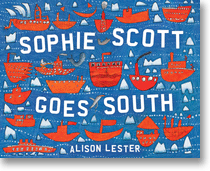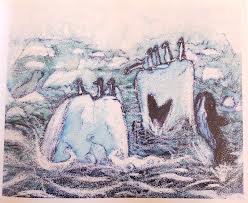Before Reading

Meet Alison Lester
I'm sure you will already know Alison and all the wonderful books she has written over the years.
Click HERE to remind yourself of some of these books!
I'm sure you will already know Alison and all the wonderful books she has written over the years.
Click HERE to remind yourself of some of these books!
Comparing two Alison Lester Books

Here we are reading another story by Alison Lester. Alison Lester wrote, Are We There Yet!
Look at the two books side by side. What is the same about them? (Shape; a journey etc) This one is called "Sophie Scott Goes South." What do you think will happen in this book? What clues are on the front cover? What clues are in the title?
Where could 'South' be?
Are We There Yet? was a book about a journey. Could this be about a journey too? What makes you think that? What clues are there on the front of this book that give us some hints about this journey and the type of landscape it might be?
Open up to the inside cover (The endpaper at the front of the book). Look at the map and use the visualiser to show children more closely where the boat will be travelling.
Look at the two books side by side. What is the same about them? (Shape; a journey etc) This one is called "Sophie Scott Goes South." What do you think will happen in this book? What clues are on the front cover? What clues are in the title?
Where could 'South' be?
Are We There Yet? was a book about a journey. Could this be about a journey too? What makes you think that? What clues are there on the front of this book that give us some hints about this journey and the type of landscape it might be?
Open up to the inside cover (The endpaper at the front of the book). Look at the map and use the visualiser to show children more closely where the boat will be travelling.

Read the story of Sophie Scott's journey with her Dad to Antarctica. It will take a while because there is so much detail in both the text and the illustration.
Use the visualiser where necessary to see some of the smaller drawings and photos more closely.
The detail is quite astonishing and there is so much to learn and enjoy
Use the visualiser where necessary to see some of the smaller drawings and photos more closely.
The detail is quite astonishing and there is so much to learn and enjoy
Afterwards

Ask the students:
- What is your response to the book?
- What does it make you think and feel about Antarctica?
- What have you learnt ?
- Why do you think Alison Lester wrote this book?
Think about this . . .
Examining text structure and organisation
Comparing visual features
- Examine how the structure of the book typifies diary entry style of writing. What are the effects of first person writing and the use of both past and present tense? ACELY1690 EN2–8B
- Compare the language, layout, illustrations and structure of the book to factual texts. Would you classify Sophie Scott Goes South as a narrative or information text? ACELY1690 EN2–8B
- Examine the use of the language of affect that tells the reader how the narrator is feeling: ‘… it’s driving everyone crazy’ ‘… my smile was so big …’ ACELA1489 EN2–11D
- Look closely at the way Sophie describes the ship and the way it is moved by the weather. Find all the similes she uses for example: ‘like we’re eating inside a washing machine.’ ‘… like being in the belly of a whale.’ What else is described using similes? ACELT1605 EN2–10C
Comparing visual features
Respond to this text in your booklet